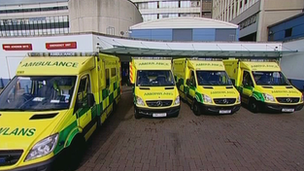Wales' ambulance transfer times worst in UK
- Published

One ambulance in Wales queued for more than six hours
Patients in Wales wait longer on average than others in the UK to be transferred to A&E departments from an ambulance, new figures show.
Some patients taken by ambulance to A&E departments waited in vehicles much longer than the recommended 15 minutes.
One case in Wales involved a six-hour delay.
The Welsh government said the figures were unacceptable but added most people were waiting for an average of 20 minutes.
Longest waits
Data for ambulance services in England, Scotland and Wales was released to the BBC under the Freedom of Information Act.
Ambulance trusts were asked for their longest waits during the 12 weeks from early August to the end of October.
No service saw its longest wait dip under an hour, with many around the two-hour mark, the figures revealed.
The longest waits were seen in Wales, where one ambulance was left queuing for six hours 22 minutes.
Each weekly maximum wait in Wales for the period was above three hours.
In England, one service in the east had the longest single wait at five hours 51 minutes
'Average handover delay'
Scotland had the best record of the three countries with none of the weekly maximums exceeding two hours.
Speaking to BBC Radio Wales, Mike Collins, interim director of service delivery at the Welsh Ambulance Service, said that demand on ambulances was increasing year on year.
"I think the length of the delays... outlined really are the exception to the rule and the significant majority of the patients that we do convey to the hospital the average handover delay is 20 minutes," he said.
"When we have those levels of delays there is very close consultation with the emergency department staff just to make sure that the clinical prioritisation of the patients in the vehicles is of paramount importance and that goes on on a 15 to 20 minute basis.
"The knock-on effect is simply, if we have high level delays outside of the emergency departments, then we simply don't have the level of resources available that we need to respond to our emergency high- level calls," said Mr Collins.
Dr Aruni Sen, who is an A&E consultant at Wrexham Maelor Hospital and former chair of the Welsh Board of Emergency Medicine, explained why patient transfers occurred.
Trolley space
"It happens because the department is full and every single trolley bay is taken. If any patient has come by ambulance and could safely be put in the waiting room waiting to be seen by a triage nurse that patient can be offloaded," he said.
"If they (patients) need a trolley space to be monitored (and) those bays are full ...the patient has to wait, that is what's happening."
Mr Sen said long delays were relatively rare, but any delay over half an hour was "bad".
"If I see 200 patients a day about a quarter of them will arrive by ambulance, or a third of them so that's around 30/40 ambulances a day, of which we will probably hold, on a bad day about five, six ,10 at various times of the day, and the length of wait will vary," Mr Sen said.
"The target is 15 minutes and we will exceed that target. Half an hour to an hour would be bad and that would happen at various times," he added.
A Welsh government spokesman said: "Lengthy patient handover delays are clearly unacceptable."
But he added the long delays were the "exception to the rule" as the average waiting times were around the 20-minute mark.
- Published30 October 2013
- Published31 May 2013
- Published15 April 2013